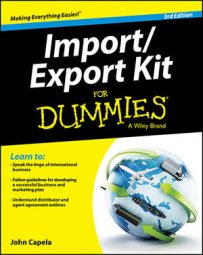When goods arrive at the port, Customs and Border Protection (CBP) makes its decision as to the dutiable status of the merchandise — the appropriate tariff classification code, as found in the Harmonized Tariff Schedule of the United States (HTSUS). The HTSUS is the primary resource for determining duty classifications.
You can use the HTSUS to determine the appropriate tariff classification number, Customs duty (tariff), and any applicable rules or regulations for the item you're importing. You'll need to determine the following:
Whether there are any special requirements or forms that apply, such as quota, visa, FDA, EPA, or DOT (Department of Transportation)
Whether the merchandise being imported qualifies for any special tariff programs, such as GSP (Generalized System of Preferences), NAFTA, or other free trade agreements
Most importers want to know the dutiable status of their products before the products arrive at the port. You have two options for finding this information — informal tariff classifications and binding decisions.
Informal tariff classifications
Every item entering the U.S. has been assigned a tariff classification number, which is the basis for all decisions relating to that item. Here are some ways to identify the tariff classification number of your product:
Discuss the product with a commodity specialist.
Access the HTSUS online.
Contact the port director where your merchandise will be entered.
Write to U.S. Customs and Border Protection. The address is Director, National Commodity Specialist Division, U.S. Customs and Border Protection, 1 Penn Plaza, 11th Floor, New York, NY 10119.
The information from any of these sources is informal and not binding.
Binding decisions
A binding ruling enables you to get binding pre-entry classification decisions prior to importing a product and filing entries with CBP. A binding ruling also allows you to get binding guidance about other CBP regulations pertaining to marking the country of origin.
Only the Office of Regulations and Rulings can give you binding classification info. You simply submit a letter to Director, National Commodity Specialist Division, U.S. Customs and Border Protection, Attention: CIE/Ruling Request, 1 Penn Plaza, 10th Floor, New York, NY 10119. You generally get a response within 30 days.
Under the newly enhanced Electronic Ruling program, the importer may submit an electronic request for a binding ruling by accessing the eRulings Template. The template lets you electronically file a binding ruling request with the National Commodity Specialist Division (NCSD) of Regulations and Rulings. Any questions or follow-up inquiries concerning the request must be made via telephone to Customs and Border Protection, Customs Information Exchange, at 646-733-3068, ext. 3062 or 3071.
The following information is required in ruling requests:
The names, addresses, and other identifying information of all interested parties
The name(s) of the port(s) at which the merchandise will be entered
A description of the transaction (for example, "A prospective importation of paper clips from South Korea")
A statement that there are, to your knowledge, no issues on the commodity pending before CBP or any court
A statement on whether you've previously sought classification advice from a CBP officer, and if so, who responded and what the advice was
A request for a tariff classification should include the following information:
A complete description of the goods; send samples (if practical), sketches, diagrams, or other illustrative materials that will be useful in supplementing the written description
Cost breakdowns of component materials and their respective quantities shown in percentages if possible
A description of the principal use of the goods (as a class or kind of merchandise) in the U.S.
Information about commercial, scientific, or common designations, as may be applicable
Any other information that may be pertinent or required for the purpose of tariff classification
Tariff classifications are binding, but duty rates are not. The classification program promotes compliance, uniformity, and accuracy, and you can rely on it when placing or accepting orders or when making any other business-related decisions.

